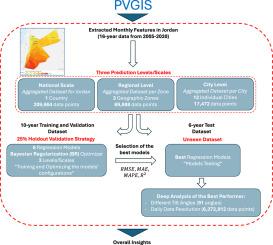用于预测倾斜表面太阳辐照的地理多尺度机器学习框架
IF 9
1区 工程技术
Q1 ENERGY & FUELS
引用次数: 0
摘要
本研究以约旦为案例,探讨了改进全球倾斜辐照(GTI)预测的挑战。这项工作的新颖之处在于开发了机器学习模型,可在国家、地区(3 个地区)和城市(12 个城市)层面预测全球倾斜辐照度,这是此前文献中尚未探索过的方法。该研究考察了针对整个国家使用单一模型与针对个别地区和城市使用定制模型的效率比较,从而揭示了模型评估中的权衡问题。研究利用均方根误差 (RMSE)、平均绝对误差 (MAE)、平均绝对百分比误差 (MAPE) 和判定系数 (R2) 等性能指标对各种回归模型进行了评估,包括神经网络 (NN)、线性回归 (LR)、回归树 (RT)、回归树集合 (ERT)、支持向量机 (SVM) 和核逼近模型。NN 始终表现最佳,在区域层面实现了最低的 RMSE(1.5787 kWh/m2)和最高的 R2(99.8600 %)。敏感性分析进一步探讨了不同时间分辨率的影响,结果表明月度数据在准确性和计算效率方面优于日度数据。最终,我们得出结论,针对特定地区的模型和月度数据分辨率是实际 GTI 预测的最佳选择。本文章由计算机程序翻译,如有差异,请以英文原文为准。

A geographic multi-scale machine learning framework for predicting solar irradiation on tilted surfaces
This study addresses the challenge of improving Global Tilted Irradiation (GTI) predictions, with Jordan serving as the case study. The novelty of the work lies in developing machine learning models that predict GTI at national, regional (3 regions), and city-specific (12 cities) levels, a previously unexplored approach in the literature. The research examines the comparative efficiency of using a single model for an entire country versus tailored models for individual regions and cities, shedding light on the trade-offs in model evaluation. Various regression models, including Neural Networks (NNs), Linear Regression (LR), Regression Trees (RTs), Ensemble of Regression Trees (ERTs), Support Vector Machine (SVM), and Kernel Approximation, were evaluated using performance metrics such as Root Mean Square Error (RMSE), Mean Absolute Error (MAE), Mean Absolute Percentage Error (MAPE), and coefficient of determination (R2). NNs consistently performed best, achieving the lowest RMSE (1.5787 kWh/m2) and highest R2 (99.8600 %) at the regional level. Sensitivity analysis further explored the impact of different time resolutions, revealing that monthly data outperformed daily data in terms of accuracy and computational efficiency. Ultimately, we conclude that region-specific models and monthly data resolution are optimal for practical GTI prediction.
求助全文
通过发布文献求助,成功后即可免费获取论文全文。
去求助
来源期刊

Energy
工程技术-能源与燃料
CiteScore
15.30
自引率
14.40%
发文量
0
审稿时长
14.2 weeks
期刊介绍:
Energy is a multidisciplinary, international journal that publishes research and analysis in the field of energy engineering. Our aim is to become a leading peer-reviewed platform and a trusted source of information for energy-related topics.
The journal covers a range of areas including mechanical engineering, thermal sciences, and energy analysis. We are particularly interested in research on energy modelling, prediction, integrated energy systems, planning, and management.
Additionally, we welcome papers on energy conservation, efficiency, biomass and bioenergy, renewable energy, electricity supply and demand, energy storage, buildings, and economic and policy issues. These topics should align with our broader multidisciplinary focus.
 求助内容:
求助内容: 应助结果提醒方式:
应助结果提醒方式:


